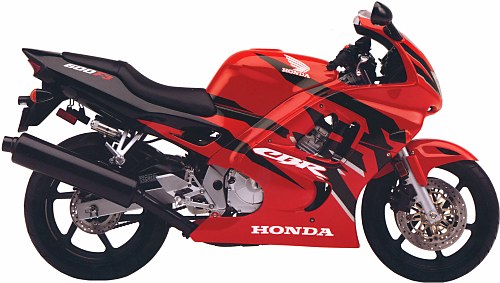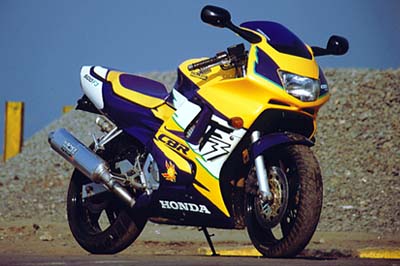F3
F3

Here's the bottom line on Honda's CBR600F3: It's awesome. Whether you're
a racer, canyon killer, commuter, or sport tourer, the CBR600F3 could be
the perfect bike for you--not only is the F3 faster, smoother and better
suspended than previous versions, it has captured that elusive quality
that Japanese motorcycles lacked in recent decades: Personality.
So what gives the new F3 its new-found personality? Look no further
than the new ram-air airbox -- not something you can see or hear in
action -- but its there, nonetheless. And it gives you serious bragging
and performance value -- the top-speed gain from this new airbox is
phenomenal.
At Honda's semi-secret proving grounds in California's Mojave desert,
we ran the new 1995 CBR600F3 side-by-side against its older sibling,
the F2. Although there was no radar gun available, the new F3 is at
least 5.0 mph faster than last year's model, and probably closer to
seven or eight: our 1995 test bike indicated 175 mph around Honda's
7.5 mile flat oval test track while the 1994 model, decidedly slower,
could only muster an indicated 167 or so. In the real world, this means
that the F3 could be pushing 160 mph.
Seven miles per hour extra doesn't sound like much of a gain until you
consider the amount of power needed to accomplish that -- basically, wind
resistance is a function of the bike's frontal area times its coefficient
of drag times the square of velocity, meaning that exponentially more
amounts of power are needed for each mile per hour gain in speed. After
doing the math, we'd guess that the new CBR600 makes seven or eight
percent more top-end power, a figure difficult to verify on a dyno since
its hard to get a 160 mph wind going in the dyno room!
In roll-on tests, the new F3 consistently chugged away from the F2,
regardless of what gear we used or the speed we started at. However,
in the real world, the deciding factor in winning roll-ons is weight:
in our impromptu sessions, the lightest testers always left the heavier
ones in the dust, regardless of what they were riding. Eventually,
though, the CBR600F3s would always catch and pass the F2s, no matter
who was riding what.
The bad news about the new F3, if there is any, is that it tips the
scales at a claimed 407.9 pounds, without fluids. Comparatively, last
year's F2 weight 2.2 pounds less -- never a good thing to gain weight
as the years go by. The heavier bike was a surprise, since Honda went
to great lengths to trim weight from the new machine: The headlight is
now made of plastic and weighs 35 percent less than last year's, while
the swingarm pivot has a larger diameter but is now hollow (generally,
larger-diameter hollow tubes are more rigid than solid ones, and can be
made lighter) to increase rigidity and save weight.
Conversely, metal has been added to the rear wheel, widening it by a
half inch, to 5.0 inches. A new, CBR600F3-specific Bridgestone Battlax
rear tire is mounted on the rear of the CBR600F3, and, according to
Bridgestone, offers the best compromise between sporting grip and life
span. Out on Honda's slick road course, the Battlax's performed well,
showing minimal signs of wear after a day's testing, though traction
wasn't as good as some racing-oriented compounds.
Inside the engine, the CBR600F3's engineers shortened the intake tracts
and bumped compression from 11.6:1 up to 12:1 through a more compact
combustion chamber and revised piston design. Further aiding power
production throughout the rev range are new, low-friction piston rings
that supposedly exert 10 percent less pressure on the cylinder wall.
The new pistons and rings are mated to lighter connecting rods, which,
in turn, are secured to a new, five-main-bearing crankshaft via narrower
crank pins--all in the interests of quicker acceleration.
Honda also ditched the old cam chain tensioner that had to be primed with
oil on reassembly. Failure to do so led to improper cam-chain tension,
meaning the valve timing would be off and the pistons could smash into
them.
The engine, fed through new, larger, 36mm Keihin semi-downdraft
carburetors (downdrafts are good for performance since the fuel will
fall down to the motor of its own weight, and therefor, the manifold
diameter can be larger) mates to a new exhaust system that features
cross-connecting tubes on the pipe's headers, a la Yoshimura race
pipes. This, says Honda, boosts midrange performance.
A new fairing on this year's model, slightly narrower and shorter,
promises improved airflow to the engine and a lower coefficient of drag,
comes in two color schemes: white, yellow & purple and white, purple
& red. The fairing, in conjunction with a redesigned front fender,
route more air to a new, curved radiatator which, due to its narrower
width, reduces the overall width of the motorcycle. Even better, the
new F3 runs five degrees cooler, due in part to increased flow to the
radiator and because Honda increased the gear ratio in the water pump
so it spins faster. In practice, the new system works: While drafting
another journalist for three laps around the high-speed oval, our test
bike never overheated despite sitting in a pool of buffeting, stagnant
air behind the lead F3. Incidentally, while trailing the other rider at
top speed, we felt no appreciable power loss -- and when pulling out of
the draft, there was no power surge either.
And while its nice to pick up such a massive top speed gain between years
-- especially if you race -- we felt an equally important improvement
was the F3's suspension. Over the Honda Proving Center's speed bump-like
surface, the new F3 performed flawlessly, absorbing walloping hits
and allowing us to rid over mounds in the middle of an apex at speed,
with confidence. In comparison, the F2's front end was unstable, prone
to tankslapping across big bumps -- that you were better off going
around--while the rear seemed overly harsh.
But there were no major revisions to the Honda's suspension. Indeed, they
use the same rear shock as last year. Instead, Honda improved handling
with a series of updates and improvements. First, the triple clamp was
strengthened, adding stability. In conjunction with a new fork, which
features spring preload adjustments and a new-for-1994 12-click rebound
adjust, that improves rebound damping by submerging the rebound damping
circuits in oil at the bottom of the fork (they used to be near the top),
Honda has virtually eliminated the scary wobble that some bumps could
set earlier models into.
At the rear, a new, less-linear rising-rate linkage hooks to the unchanged
shock, which offers rebound damping adjusters in addition to a spring
preload collar.
Out on the racetrack, the Honda's suspension worked flawlessly right
out of the box: We never had to futz with any of the suspension's knobs,
dials or other adjustments.
In truth, we would have preferred a more RR-type update with upside-
down forks and maybe 15 pounds less pork to lug around. But we certainly
wouldn't prefer to pay more than the manufacturer's suggested retail
price of $7,299 (that's in US dollars). That's a $900 price increase in
one year! But the good news for value shoppers -- which, as the dollar
continues to drop against the yen, is just about all of us -- is that the
new 1995 CBR600F3 will give us the best of both worlds: Race-winning speed
and technology coupled with good ergonomics, a friendly riding position,
and Honda's rock-solid reliability.
EXCLUSIVE '96 CBR600F3 FEATURES
Dual-Stage Air Induction system introduces a high-volume stream
of cool, fresh air into the intake system to boost overall engine
performance. However, unlike other ram air systems, which generally
are designed to be eftective only at higher speeds, the Dual-Stage Air
Induction system realizes a major boost in performance at all speeds,
along with sharper throttle response and excellent linearity. This
was achieved through the development of an innovative new two-stage
system that precisely balances the air pressure within the carburetors'
float and vacuum chambers with the air flowing through their bores. This
reduces air pressure differentials that can adversely affect carburetor
performance. The system consists of multiple intake ducts that feed
pressurized air directly into the carburetor chambers to ensure optimal
performance at both low and high speeds.
ENGINE
Liquid-cooled DOHC four-cylinder engine features light weight and high power.
One-piece upper crankcase/cylinder assembly and right-side camshaft-drive
layout combine high rigidity and compact dimensions.
Sixteen-valve cylinder head incorporates a narrow, 32' included valve angle.
Compact combustion chambers and 12:1 compression ratio combine with
low-friction piston rings, light connecting rods and small crank-pin
diameters for excellent engine power and response.
Large, 36mm slanted flat-slide CV carburetors deliver responsive performance.
Computer-controlled ignition system using a three-dimensional map closely
monitors throttle position and engine speed for precise response.
Mechanical cam chain adjuster gives quiet, reliable service in demanding
conditions.
Direct, shim-under-bucket valve actuation system is compact, ensures
high-rpm durability, and offers 16,000 mile valve-maintenance
intervals.
NR-type curved radiator with large surface area.
High-capacity, liquid-cooled oil cooler.
Six-speed close-ratio transmission matches the engine's power band.
Four-into-two-into-one exhaust system gives a significant boost
to mid-range power. Six-liter. canister-style silencer allows high
performance while maintaining low noise levels.
CHASSIS/SUSPENSION
Lightweight twin-spar steel frame is extremely rigid and offers precise handling.
Rigid, 41mm cartridge fork with spring preload adjusters features rebound
damping adjuster submerged low in oil reselvoir to greatly reduce aeration
during hard usage. CBR900RR-style fork protectors installed on top of
sliders.
Pro-Link rear suspension system features spring preload and rebound
and compression damping adjustability. Advanced DeCarbon-type shock has
swirl-type oil passages for smooth valve operation.
Floating front disc brakes feature large-diameter 296mm drilled rotors
using twin-piston calipers with sintered metal pads.
Single rear disc brake.
Cast aluminom wheels with wide, 5-inch rear rim permit mounting of
wide-section 6-inch street tires and racing slicks for track use.
Fairing and bodywork design offer excellent wind and weather protection and low drag.
Durable, sealed O-ring drive chain.
Rectangular-section swingarm is lightweight and rigid.
Carefully designed seat/peg/bar relationship and wide seat offer good comfort and control.
ADDITIONAL FEATURES
Fully electronic one-piece instrument panel with electric speedometer
eliminates wires and cable and reduces weight and complexity while
ensuring high accuracy.
Lightweight, all-plastic headlight is 35 percent lighter than conventional
glass headlights. The lens projects a sharper-edged pattern, and is
protecte by a hard-coated, flush-mounted plastic cover.
Stalk-mounted front turn indicators allow easy removal for racing.
Left side-panel has a vent to allow a U-lock or cable to be hooked around
sub-frame for added security.
Integrated ignition switch/fork lock.
Large-volume, 4.5-gallon fuel tank gives good cruising range.
Folding aero mirrors.
Convenient push-to-cancel turn-signal switch.
One-year transferable unlimited-mileage warranty.

SPECIFICATIONS
Model: CBR600F3
Engine Type: 599cc liquid-cooled inline four-cylinder
Bore and Stroke: 65mm x 45.2mm
Compression Ratio: 12.0:1
Yalve Train: DOHC; four valves per cylinder
Carburetion: Four 36mm flat-slide CV
Ignition: Computer-controlled digital transistorized with three-dimensional mapping
Transmission: Close-ratio six-speed
Final Drive: O-ring-sealed chain
Suspension Front: 41mm cartridge fork with spring preload and rebound damping adjustability; 5.1 inces travel
Suspension Rear: Pro-Link single shock with seven-way spring preload, and rebound and compression damping adjustability; 4.3 inches travel
Brakes Front: Dual disc with twin-piston calipers
Brakes Rear: Single disc
Tires Front: 120/60Z-17 Bridgestone radial
Tires Rear: 160/60Z-17 Bridgestone radial
Whcelbase: 55.3 inches
Seat Height: 31.9 inches
Dry Weight: 405.6pounds
Fuel Capacity: 4.5gallons
COLOR
Red/White/Black
Pearl Yellow/Purple/White
Performance
Performance (unofficial)
Fuel Consumption 36 - 50 mpg; 45.9 mpg average
Average Touring Range 206 miles
Top Speed 161.4 mph
Standing 1/4-mil 11.02s @ 124.1 mph
Top Gear Roll-ons:
60-80 mph: 4.53 sec
80-100 mph: 5.36 sec

